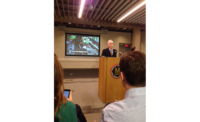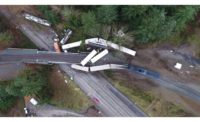A prolonged short circuit in the third-rail power system of Washington, D.C.’s Metrorail system has been determined to be the probable cause for a January 2015 electrical arcing and smoke incident that killed one passenger and injured dozens more, the National Transportation Safety Board (NTSB) said on May 3.
In announcing the findings of its 15-month investigation of the incident, which occurred in a tunnel adjacent to the L’Enfant Square station, the Board faulted the Washington Metropolitan Area Transit Authority (WMATA) for “ineffective inspection and maintenance practices” that created conditions for electrical arc tracking to occur in a 16-ft long jumper cable. Investigators said the arc tracking was aided by the presence of contaminants and moisture on third-rail cables and inside cable connector assemblies, which were found to have been lacking required sealing components.
Also contributing to the death and injuries were the tunnel’s 1970s-era smoke-detection and ventilation systems, installed before implementation of the National Fire Protection Association’s NFPA 130, Standard for Fixed Guideway Transit and Passenger Rail Systems, which was first published in 1983. The tunnel’s ventilation equipment was designed for heat removal and temperature control, rather than for emergency smoke removal.
The NTSB also faulted WMATA control and operations personnel for failing to follow established safety procedures, and the District of Columbia’s Fire and EMS Department for insufficient training in underground mass-casualty incidents.
WMATA has come under fire in recent years for its inability to keep pace with maintenance needs on the now 40-year old rail system, which links the nation’s capital to the Maryland and Virginia suburbs. Unlike other metropolitan transit networks, WMATA has no dedicated funding source, relying instead on annual contributions from the jurisdictions it serves, and a 10-year, $1.5 billion federal grant that expires in 2018.
This organizational structure likewise compromises Metrorail’s safety, the NTSB said, noting the absence of sufficient resources, technical capacity, and enforcement authority on the part of WMATA’s current three-state safety oversight committee, as well as deficiencies with the Federal Transit Administration (FTA), which was given temporary oversight of WMATA’s safety operations until a new three-state independent commission is established next year.
The NTSB issued 24 recommendations to WMATA, covering areas such as inspection and maintenance procedures to prevent water intrusion in tunnels; smoke detection and ventilation system upgrades; the elimination of safety pathway obstructions that could impede passenger evacuation and responder access; and numerous other operational and management changes.
In addition, the Board called on the FTA to issue regulatory standards for tunnel infrastructure inspection, maintenance, and repair that incorporate applicable industry consensus standards.
The NTSB also reiterated its contention that the Federal Railroad Administration is better equipped to manage WMATA’s safety issues, and made an urgent recommendation to that effect last September.
In his opening remarks, board chairman Christopher Hart noted that the this was the 13th NTSB investigation of an accident on Metrorail, and the ninth since 2004. Previous investigations have already netted WMATA more than 100 safety recommendations, which is why, says Hart, the agency needs “a regulatory structure with rules, inspections and enforcement. The FRA can provide all three.”
Hart added that while WMATA and FTA deserve credit for recent efforts aimed at improving Metrorail safety, including a one-day system-wide shutdown on March 16 to address other potential electric-arcing hazards, endemic problems with WMATA’s safety culture remain.
“Only robust, permanent safety oversight can assure that positive safety improvements will become the norm, and continue to be the norm, throughout WMATA’s rail operations,” Hart said.





Post a comment to this article
Report Abusive Comment